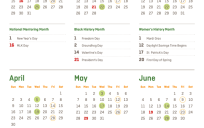This isn’t theoretical. I’m speaking Wed. afternoon, and I’m overwhelmed by the options. These are very high-level execs. They have 1001 issues to worry about, and we need to break into their consciousness to help them get started.
Recent Articles on GovLoop
- How AI Can Help Agencies Deliver Better Constituent Experiences
- How Can Agencies Strengthen Their Defense Against Insider Threats?
- Process Automation: The Efficient Alternative to Paper-Based Systems
- Fostering Creativity on Your Team
- How to Shift to a Continuous Modernization Mindset
- How to Build a Better Endpoint Security Strategy
- How Cross-Skilling Can Help Address IT Skills Gaps
- Learn Something New With Our April Online Training LineUp
- Why Network Modernization Tops the IT Agenda
- Digital Transformation: How to Reduce Internet Connectivity Risks




The conversation used to take place at the water cooler and anything that was discussed usually stayed within the confines of the office. In today’s Web 2.0 world the “water cooler” is the Internet (forums, Facebook, MySpace, Twitter, etc) and the are of confinement is the entire planet. In the past you could deal with water cooler chat by ignoring it…that was the old way of thinking and dealing. Today, you MUST be involved in the chatter, you need to know what is being said and what isn’t. If you’re not involved, you’re not in tune.
By being in the conversation, you also have the opportunity to get more involved with your customers, your partners, and your employees. This puts you in a unique position that other CIOs may not be in to help improve your organization’s communications, productivity, scalability, and even reputation. The benefits are there, you should just need to start drinking from the same cooler.
Two qui k points.
1. Agree with Scott 100% but may add need to consider long tail issues and search. Social tools help get out message out and without using these tools we can become practically invisible.
2. Resource leveraging. A new twitter account for us has resulted in people already retweeting in multiple foreign languages. No way we could duplicate that effort ourselves.
First – I would find out what about Web 2.0 helps them solve their problems. Too many times, we want to have discussions about topics we’re comfortable with. What is the mission of the agency you’re speaking with? What is the culture? Are they agents of change, or more status quo? If there is no linkage between what you are talking about and the 1001 issues you mentioned, they won’t listen.
Showing how Web 2.0 helps them as a CIO meet their mission, is the difference between showing outputs and outcomes. They get measured on outcomes. There is still resistance to Web 1.0 Sometimes it’s also the specific words – social media vice collaboration. Social media comes with preconceived notions, such as not secure, a fad, used by teenagers and not serious business and government entities, etc. However, talking about how new forms of collaboration can increase the speed and precision in their operations, linkage to scorecards, productivity, retention and recruiting and the like change the value proposition.
Sometimes it’s also the specific words – social media vice collaboration. Social media comes with preconceived notions, such as not secure, a fad, used by teenagers and not serious business and government entities, etc. However, talking about how new forms of collaboration can increase the speed and precision in their operations, linkage to scorecards, productivity, retention and recruiting and the like change the value proposition.
I also look at social media as a human capital issue. Government is competing against the private sector for the new workforce. Think of yourself – are you more likely to go to work where the environment closely matches what you already have in your personal life (IM, social media, Twitter, Flickr, SMS, etc.), or one where there is limited collaboration and interaction?
Be a good doctor – listen to your patient, diagnose…then prescribe.
Just my .02…good luck.
Terrific advice, everyone. Morgan in particular, your thoughts mirror mine in many ways. In fact, I’m thinking I’m going to do the Web 2.0 thing at the beginning and ask them what they know and think about these tools, and ask them why a) they aren’t doing them yet and b) they’re interested in them at all.
BTW, I do know who I’m talking to. I’m just not identifying them here because my purpose is to gather ideas, not “out” anyone or embarrass them.
I’m just not identifying them here because my purpose is to gather ideas, not “out” anyone or embarrass them.
Gotcha – best of luck. Sometimes, I feel the only solution for certain long-held beliefs is a change in generations. This upcoming generation is growing up with these tools – it’s second nature.
First, there is a paradigm change taking place right now. This is not a matter of a few interesting tools that they can used or not used. Just like computers let us compile, organize, and manipulate information, we now have a different way of collecting, organizing, and manipulating information that will, quite simply, change the way we do so many things. (I think you’ve got examples, but the McCain/Obama election, especially fundraising and political organizing, is a good contrast.) Good historic metaphor is the fact that many thought the radio was an interesting gimmick that, at best, might help ships navigate. That was turned upside down when it was used to capture a murderer and everyone suddenly realized this was something very powerful (see the book “Thunderstruck”). We may still be at the “isn’t this quaint” stage, but the moment for Web 2.0 will come.
Second, let’s be realistic about the limitations. This isn’t magic and there are barriers. You can’t get the benefits if, for instance, there aren’t already people willing to collaborate on something. It is possible to oversell the changes that are happening.
Third, this means they need to become familiar with these tools and start to play with them and see what works and doesn’t. They need to do it on a personal level. Perhaps get someone in the audience to talk about their own experience with facebook or GovLoop. (Could be a plant or you could do it cold.) Dare those that haven’t to join a social network. My experience is within a week people discover the possibilities of communicating much more easily with people they hardly ever communicated with including photos and articles and videos, etc. That’s when they start to ‘get it’ and start thinking of the possibilities in a work application. Afterall, virtually all the work we do is based on communicating with other people. Why wouldn’t we use the best tools available to do that?
Don’t know if that helps, but it was fun to write.
Excellent points, Marcus. I think you have a future in social media strategy. I really like the idea of drawing them into the conversation rather than lecturing them.
I really like the idea of drawing them into the conversation rather than lecturing them.
I recently redesigned our WebPages to minimize them. We had too many pages, too many links to random things, too much and too much frustrates users. So, I got it pared down to simple action items, answering those age old questions, who are my users, what do they want and why are they on my site. And then I added my newest question, what do I want them to leave knowing about what we do?
I do the questions, re-write the content, move pages around and remove other pages, update links, modify some of the structure and now, it’s time for concurrence and I’m now dealing with trying to figure out a way to explain the new things to add (Blog) and link up to (Facebook, twitter, MySpace, Plurk, etc…) and how this will help us with the job of getting the information out, getting users to understand it and to make all of our lives easier and better.
I was thinking that the way to start my approach to the salesmanship of these things is to use Change.gov and the campaign websites as my starting point for using these services, but the #1 question I’m anticipating is 508 compliance.
So, my comment (as long winded as this is) is more of a question about how to do the sales, what questions to ask and OMG…is anything that is Web2.0ish also 508 compliant? And how can I test it or check into it?
And one more question, why is the comment box so tiny? Comments should be more square, or at least easier to read when I’m typing it. I hate having to pull from Word and paste in…I’m a lazy user just like everyone else out there.
Kirsten: lots of Web 2.0 is accessible. Blogs, for instance, are still primarily text, and it’s easy to create alt text for images. Embedded videos get tougher, but videos can carry captions if you display them correctly.
As for the comment box here, I don’t know. I assume that’s a ning default size (ning.com is the company who provides the service on which GovLoop is built).
Quick. Connected. Convertable. Convenient.
Engage and communicate with people you don’t have time to meet
Receive ideas and comments from staff
Level the hierarchies::Open the idea market
Specific to the power of only one web 2.0 ap, Twitter, you might want to use the attached for an anecdote or two: http://news.bbc.uk/2/hi/americas/7834755.stm
I missed the web cast yesterday – is there a way to see it? Interested in any sort of synopsis of what went down. What examples or discussions seemed to go particularly well – were there any of those “lightbulb” moments for CIOs/others in your audience? I enjoyed reading the input folks provided here and will incorporate some of these tactics into my own sales job within the gov. What has come as a huge surprise to me lately is the number of my “fellow” IT colleagues who “don’t get” web 2.0 and their resistance to its use. That’s the last thing we need! We’re supposed to be the ones that figure out how to do this better, safer, and to best effect… not the ones who whine on the sidelines.
@Laura: do you mean my webcast on mixing Web 1.0 and 2.0 for Earth Day? I did that as a different thing from when I spoke to the CIOs last week. At any rate, you can see both presentations online. The one for the CIOs is titled “Social Media and the Gov’t.”
I didn’t do a synopsis, and I’m not sure I’d feel comfortable reporting out on the mtg. anyway. I’ll invite the organizer to post a comment here, though.